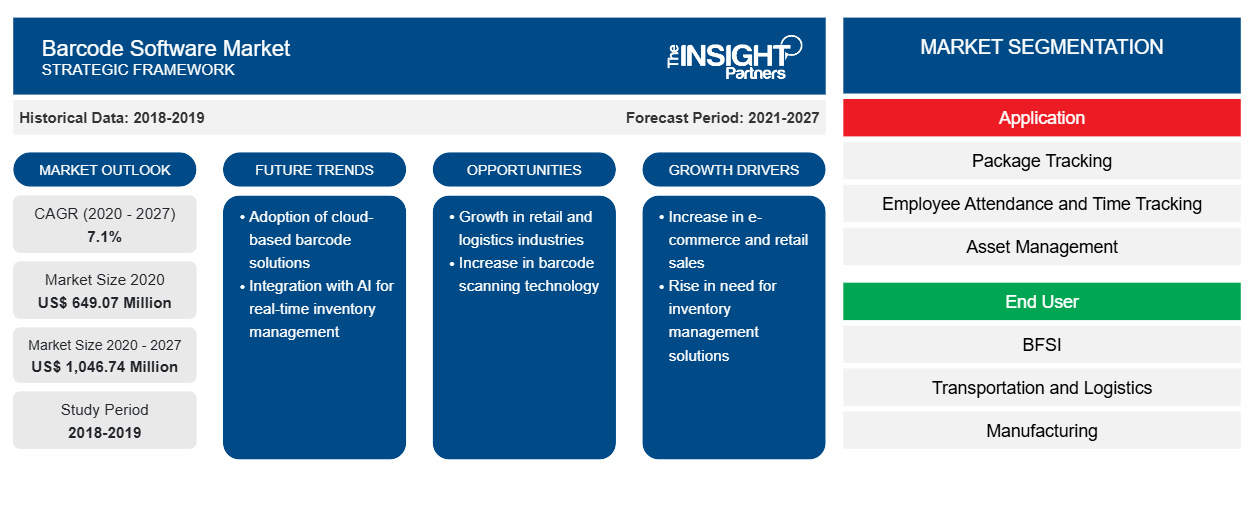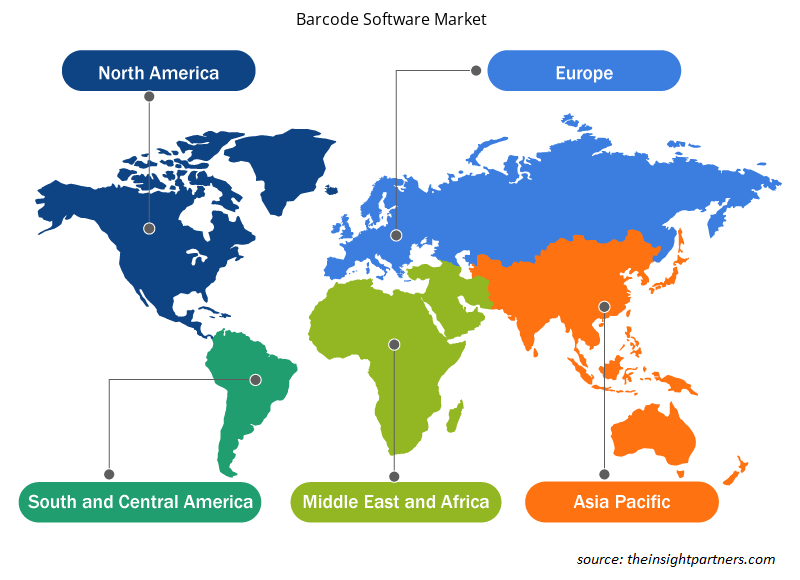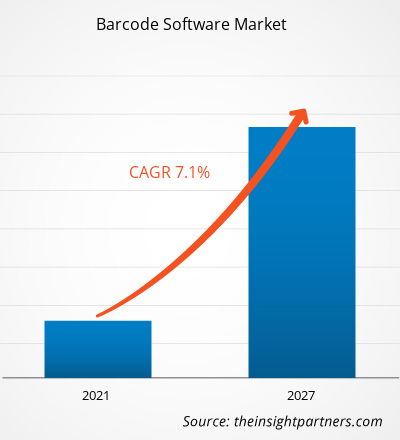The barcode software market size was valued at US$ 881.03 million in 2024 and is expected to reach US$ 1,378.29 million by 2031; the market is estimated to record a CAGR of 6.8% from 2025 to 2031. The rising popularity of cloud-based barcode software is likely to be a key market trend.
Barcode Software Market Analysis
Barcode software supports a range of platforms, including desktop systems, mobile devices, and cloud-based environments, making it adaptable and versatile to the unique needs of various organizations. Factors such as the growing retail and e-commerce sector and advancements in barcode technology are driving the barcode software market. The barcode software market is anticipated to grow during the forecast period owing to the increasing adoption of AI-powered barcode readers and a growing preference for wearable barcode readers. The rising popularity of cloud-based barcode software is expected to be a key trend in the barcode software market. However, dependency on scanners may hamper the barcode software market growth.
Barcode Software Market Overview
Barcode software encompasses applications specifically developed to create, print, and manage barcodes. A barcode is a machine-readable code consisting of parallel bars or lines of varying widths that represent data. This software enables users to generate barcode images or labels, which can be scanned and decoded by barcode scanners or mobile devices. It integrates with other business systems and supports multiple platforms, facilitating smooth data exchange and enhancing overall operational efficiency. Barcode software is widely utilized across various industries for purposes such as inventory management, product tracking, point-of-sale systems, and supply chain management. Barcode software facilitates the creation, printing, and management of barcodes for various applications, from inventory tracking to product labeling. Popular options include BarTender and ZebraDesigner, offering features such as label design, integration with systems, and scalability. The software integrates effortlessly with other business systems, ensuring smooth data exchange across platforms. This integration enhances overall operational efficiency by enabling real-time updates, minimizing human error, and ensuring accuracy in tracking and managing inventory.
Customize This Report To Suit Your Requirement
You will get customization on any report - free of charge - including parts of this report, or country-level analysis, Excel Data pack, as well as avail great offers and discounts for start-ups & universities
Barcode Software Market: Strategic Insights

- Get Top Key Market Trends of this report.This FREE sample will include data analysis, ranging from market trends to estimates and forecasts.
You will get customization on any report - free of charge - including parts of this report, or country-level analysis, Excel Data pack, as well as avail great offers and discounts for start-ups & universities
Barcode Software Market: Strategic Insights

- Get Top Key Market Trends of this report.This FREE sample will include data analysis, ranging from market trends to estimates and forecasts.
Barcode Software Market Drivers and Opportunities
Growth of Retail and E-commerce Sector
As stated by the International Trade Administration, by 2026, the global B2B e-commerce market is projected to reach a staggering US$ 36 trillion, highlighting the immense scale and potential of this sector. Similarly, in February 2025, the Census Bureau of the Department of Commerce announced the estimate of US retail e-commerce sales for the fourth quarter of 2024. In the fourth quarter of 2024, e-commerce sales represented 16.4% of total retail sales, amounting to US$ 352.9 billion, a 22.1% increase from the third quarter of 2024. Compared to the fourth quarter of 2023, e-commerce sales grew by 9.3%, while total retail sales saw a 4.5% increase. For the entire year of 2024, total e-commerce sales reached an estimated US$ 1,192.6 billion, reflecting an 8.1% growth from 2023. The rapid growth of the retail and e-commerce sectors globally is pushing the need for efficient inventory and supply chain management systems. Barcode software allows businesses to improve stock management, track product movement in real time, and offer better customer service. As e-commerce grows, the need for barcode scanning and tracking software becomes even more critical to maintain accurate order fulfillment. Hence, the growing retail and e-commerce sector drives the barcode software market.
Increasing Adoption of AI-Powered Barcode Readers
The barcode software market is experiencing significant growth, driven by technological advancements and an increasing demand for automation and efficiency across various manufacturing sectors. The introduction of these advanced barcode readers signifies a growing trend toward the adoption of AI-powered solutions in the barcode software market. For instance, in January 2025, Cognex Corporation, a global leader in industrial machine vision, continued to drive innovation in this space with the launch of its latest offerings, the DataMan 290 and 390 barcode readers. These new products leverage cutting-edge AI technology to deliver unparalleled decoding accuracy and reliability, making them an essential tool for enhancing operational productivity. The introduction of these advanced readers not only addresses complex barcode scanning challenges but also unlocks numerous opportunities in the evolving barcode software market. Cognex's DataMan 290 and 390 barcode readers are a significant leap forward in industrial scanning technology. Powered by advanced AI, these readers ensure high-performance decoding across a wide range of barcode types and manufacturing environments. The integration of AI allows the devices to learn and adapt to different scanning conditions, improving accuracy and speed in real-time, even under challenging conditions, such as low contrast, damaged, or poorly printed barcodes. This innovation provides manufacturers with a versatile solution that enhances efficiency and minimizes downtime.
Barcode Software Market Report Segmentation Analysis
Key segments that contributed to the derivation of the barcode software market analysis are deployment, barcode type, application, and end-use industry.
- In terms of deployment, the barcode software market is bifurcated into on-premise and cloud. The cloud segment dominated the market in 2024.
- Based on barcode type, the market is segmented into 1D barcodes and 2D barcodes. The 1D barcodes segment dominated the market in 2024.
- In terms of application, the market is segmented into inventory management, point-of-sale (POS) operations, asset management, employee attendance and time tracking, and others. The inventory management segment dominated the market in 2024.
- Based on end-use industry, the barcode software market is divided into BFSI, transportation and logistics, manufacturing, healthcare, retail and e-commerce, and others. The retail and e-commerce segment dominated the market in 2024.
Barcode Software Market Share Analysis by Geography
- The barcode software market is segmented into five major regions: North America, Europe, Asia Pacific (APAC), the Middle East & Africa (MEA), and South & Central America. North America dominated the market in 2024, followed by Europe and Asia Pacific.
- North America holds a dominant position in the global barcode software market, owing to the early adoption of cutting-edge technologies; the strong presence of key market players; and the demand for automation in logistics, retail, and inventory management. The region has a well-established infrastructure, along with investments in smart manufacturing and e-commerce. Moreover, according to The Enterprise World, the US is a frontrunner in global QR code usage, responsible for 42.2% of global scans in 2022, with this share rising to 43.9% in 2023.
- In Europe, the barcode software market is expanding steadily, propelled by the region's strong manufacturing base, particularly in industries such as automotive, consumer electronics, and pharmaceuticals. The adoption of barcode solutions for inventory management, supply chain optimization, and regulatory compliance is growing significantly in the region. Additionally, the increasing trend toward Industry 4.0 and the digitalization of European manufacturing is boosting demand for barcode software solutions.
- Asia Pacific is expected to witness the highest growth rate in the barcode software market. This surge is driven by the rapid industrialization in emerging economies such as China and India, where barcode software is being increasingly adopted for retail, logistics, and manufacturing. The focus on automation, smart logistics, and the development of e-commerce platforms is growing steadily in the region. Moreover, the demand for barcode-based solutions in the food and beverages, retail, and healthcare sectors is growing. Furthermore, in 2022, according to VISA, 93% of consumers in Southeast Asia utilized various cashless payment methods, including QR codes for transactions. The demand for efficient digital payment solutions is increasing in the region, driving technological advancements and market expansion.
Barcode Software Market Regional Insights
The regional trends and factors influencing the Barcode Software Market throughout the forecast period have been thoroughly explained by the analysts at The Insight Partners. This section also discusses Barcode Software Market segments and geography across North America, Europe, Asia Pacific, Middle East and Africa, and South and Central America.

- Get the Regional Specific Data for Barcode Software Market
Barcode Software Market Report Scope
| Report Attribute | Details |
|---|---|
| Market size in 2024 | US$ 881.03 Million |
| Market Size by 2031 | US$ 1,378.29 Million |
| Global CAGR (2025 - 2031) | 6.8% |
| Historical Data | 2021-2023 |
| Forecast period | 2025-2031 |
| Segments Covered |
By Barcode Type
|
| Regions and Countries Covered | North America
|
| Market leaders and key company profiles |
Barcode Software Market Players Density: Understanding Its Impact on Business Dynamics
The Barcode Software Market is growing rapidly, driven by increasing end-user demand due to factors such as evolving consumer preferences, technological advancements, and greater awareness of the product's benefits. As demand rises, businesses are expanding their offerings, innovating to meet consumer needs, and capitalizing on emerging trends, which further fuels market growth.
Market players density refers to the distribution of firms or companies operating within a particular market or industry. It indicates how many competitors (market players) are present in a given market space relative to its size or total market value.
Major Companies operating in the Barcode Software Market are:
- Bluebird Inc.
- Honeywell International Inc.
- Dynamic System Inc.
- Datalogic SpA
- DENSO ADC
- General Data Company, Inc.
Disclaimer: The companies listed above are not ranked in any particular order.

- Get the Barcode Software Market top key players overview
Barcode Software Market News and Recent Developments
The barcode software market is evaluated by gathering qualitative and quantitative data post primary and secondary research, which includes important corporate publications, association data, and databases. A few of the developments in the barcode software market are listed below:
- Honeywell (Nasdaq: HON) announced that its SwiftDecoder barcode-decoding software will be integrated into Corvus Robotics' self-flying inventory drones. This pioneering solution will be used within warehouses and distribution centers (DCs) to make tracking rapidly changing inventory quicker and more accurate for retailers, distributors, and manufacturers at the case and pallet levels.
(Source: Honeywell, Press Release, March 2025)
- Revenova now has the TEC-IT Barcode API integrated into its Transportation Management System (TMS). With a TEC-IT subscription, they can use the Online Barcode Generator, which allows easy barcode creation without extra programming. This feature simplifies logistics management and inventory tracking.
(Source: TEC-IT Datenverarbeitung GmbH, Press Release, November 2024)
Barcode Software Market Report Coverage and Deliverables
The "Barcode Software Market Size and Forecast (2021–2031)" provides a detailed analysis of the market covering the areas mentioned below:
- Barcode software market size and forecast at global, regional, and country levels for all the key market segments covered under the scope
- Barcode software market trends, as well as market dynamics such as drivers, restraints, and key opportunities
- Detailed PEST and SWOT analysis
- Barcode software market analysis covering key market trends, global and regional framework, major players, regulations, and recent market developments
- Industry landscape and competition analysis covering market concentration, heat map analysis, prominent players, and recent developments for the barcode software market
- Detailed company profiles
Frequently Asked Questions
What are the driving factors impacting the Barcode Software Market?
Growth of retail and e-commerce sector and advancements in barcode technology are driving the market growth.
What are the future trends of the Barcode Software Market?
Rising popularity of cloud-based barcode software is a key trend in the market.
Which are the leading players operating in the Barcode Software Market?
Bluebird Inc., Honeywell International Inc., Dynamic System Inc., Datalogic SpA, DENSO ADC, General Data Company, Inc., Zebra Technologies Corp, NCR VOYIX Corp, TKX Corp SAS, Archon Systems Inc., Wasp Barcode Technologies, TEC-IT Datenverarbeitung GmbH, BSD InfoTech Pvt. Ltd., Foxit Software Inc., and Zoho Corp Pvt Ltd are major players in the market.
What would be the estimated value of the Barcode Software Market by 2031?
The market is expected to reach a value of US$ 1378.29 million by 2031.
What is the expected CAGR of the Barcode Software Market?
The market is anticipated to expand at a CAGR of 6.8% during 2025-2031.
- Historical Analysis (2 Years), Base Year, Forecast (7 Years) with CAGR
- PEST and SWOT Analysis
- Market Size Value / Volume - Global, Regional, Country
- Industry and Competitive Landscape
- Excel Dataset
- Parking Meter Apps Market
- eSIM Market
- Advanced Distributed Management System Market
- Online Exam Proctoring Market
- Electronic Data Interchange Market
- Maritime Analytics Market
- Cloud Manufacturing Execution System (MES) Market
- Robotic Process Automation Market
- Digital Signature Market
- Manufacturing Execution System Market
Testimonials
Reason to Buy
- Informed Decision-Making
- Understanding Market Dynamics
- Competitive Analysis
- Identifying Emerging Markets
- Customer Insights
- Market Forecasts
- Risk Mitigation
- Boosting Operational Efficiency
- Strategic Planning
- Investment Justification
- Tracking Industry Innovations
- Aligning with Regulatory Trends
Yes! We provide a free sample of the report, which includes Report Scope (Table of Contents), report structure, and selected insights to help you assess the value of the full report. Please click on the "Download Sample" button or contact us to receive your copy.
Absolutely — analyst assistance is part of the package. You can connect with our analyst post-purchase to clarify report insights, methodology or discuss how the findings apply to your business needs.
Once your order is successfully placed, you will receive a confirmation email along with your invoice.
• For published reports: You’ll receive access to the report within 4–6 working hours via a secured email sent to your email.
• For upcoming reports: Your order will be recorded as a pre-booking. Our team will share the estimated release date and keep you informed of any updates. As soon as the report is published, it will be delivered to your registered email.
We offer customization options to align the report with your specific objectives. Whether you need deeper insights into a particular region, industry segment, competitor analysis, or data cut, our research team can tailor the report accordingly. Please share your requirements with us, and we’ll be happy to provide a customized proposal or scope.
The report is available in either PDF format or as an Excel dataset, depending on the license you choose.
The PDF version provides the full analysis and visuals in a ready-to-read format. The Excel dataset includes all underlying data tables for easy manipulation and further analysis.
Please review the license options at checkout or contact us to confirm which formats are included with your purchase.
Our payment process is fully secure and PCI-DSS compliant.
We use trusted and encrypted payment gateways to ensure that all transactions are protected with industry-standard SSL encryption. Your payment details are never stored on our servers and are handled securely by certified third-party processors.
You can make your purchase with confidence, knowing your personal and financial information is safe with us.
Yes, we do offer special pricing for bulk purchases.
If you're interested in purchasing multiple reports, we’re happy to provide a customized bundle offer or volume-based discount tailored to your needs. Please contact our sales team with the list of reports you’re considering, and we’ll share a personalized quote.
Yes, absolutely.
Our team is available to help you make an informed decision. Whether you have questions about the report’s scope, methodology, customization options, or which license suits you best, we’re here to assist. Please reach out to us at sales@theinsightpartners.com, and one of our representatives will get in touch promptly.
Yes, a billing invoice will be automatically generated and sent to your registered email upon successful completion of your purchase.
If you need the invoice in a specific format or require additional details (such as company name, GST, or VAT information), feel free to contact us, and we’ll be happy to assist.
Yes, certainly.
If you encounter any difficulties accessing or receiving your report, our support team is ready to assist you. Simply reach out to us via email or live chat with your order information, and we’ll ensure the issue is resolved quickly so you can access your report without interruption.















The List of Companies - Barcode Software Market
- Honeywell International Inc
- Dynamic System Inc.
- Datalogic SpA
- DENSO ADC
- General Data Company, Inc.
- Zebra Technologies Corp
- NCR VOYIX Corp
- Zebex Industries Inc
- TKX Corp SAS
- Archon Systems Inc.
- Wasp Barcode Technologies
- TEC-IT Datenverarbeitung GmbH
- BSD InfoTech Pvt. Ltd.
- Foxit Software Inc.
- Zoho Corp Pvt Ltd






 Get Free Sample For
Get Free Sample For